Community Profile of City of Banyule
VerifiedAdded on 2023/06/03
|9
|2253
|125
AI Summary
This report is a community profile of City of Banyule. It covers the physical characteristics of the community, health specific services and organizations, community demographics and other community institutions and organizations. At the end of this report, some conclusions have been drawn explaining the possible weaknesses and strengths of the community health.
Contribute Materials
Your contribution can guide someone’s learning journey. Share your
documents today.
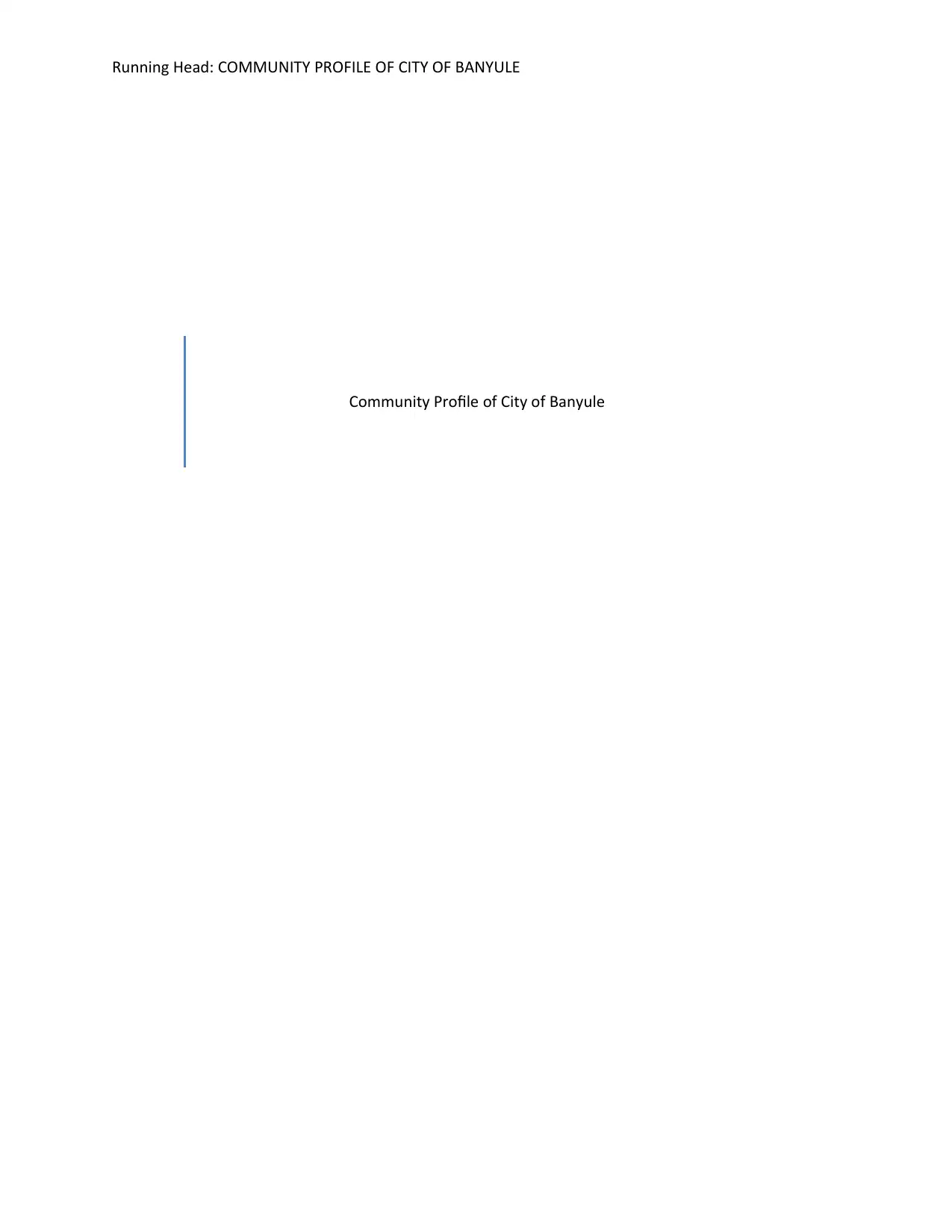
Running Head: COMMUNITY PROFILE OF CITY OF BANYULE
Community Profile of City of Banyule
Community Profile of City of Banyule
Secure Best Marks with AI Grader
Need help grading? Try our AI Grader for instant feedback on your assignments.
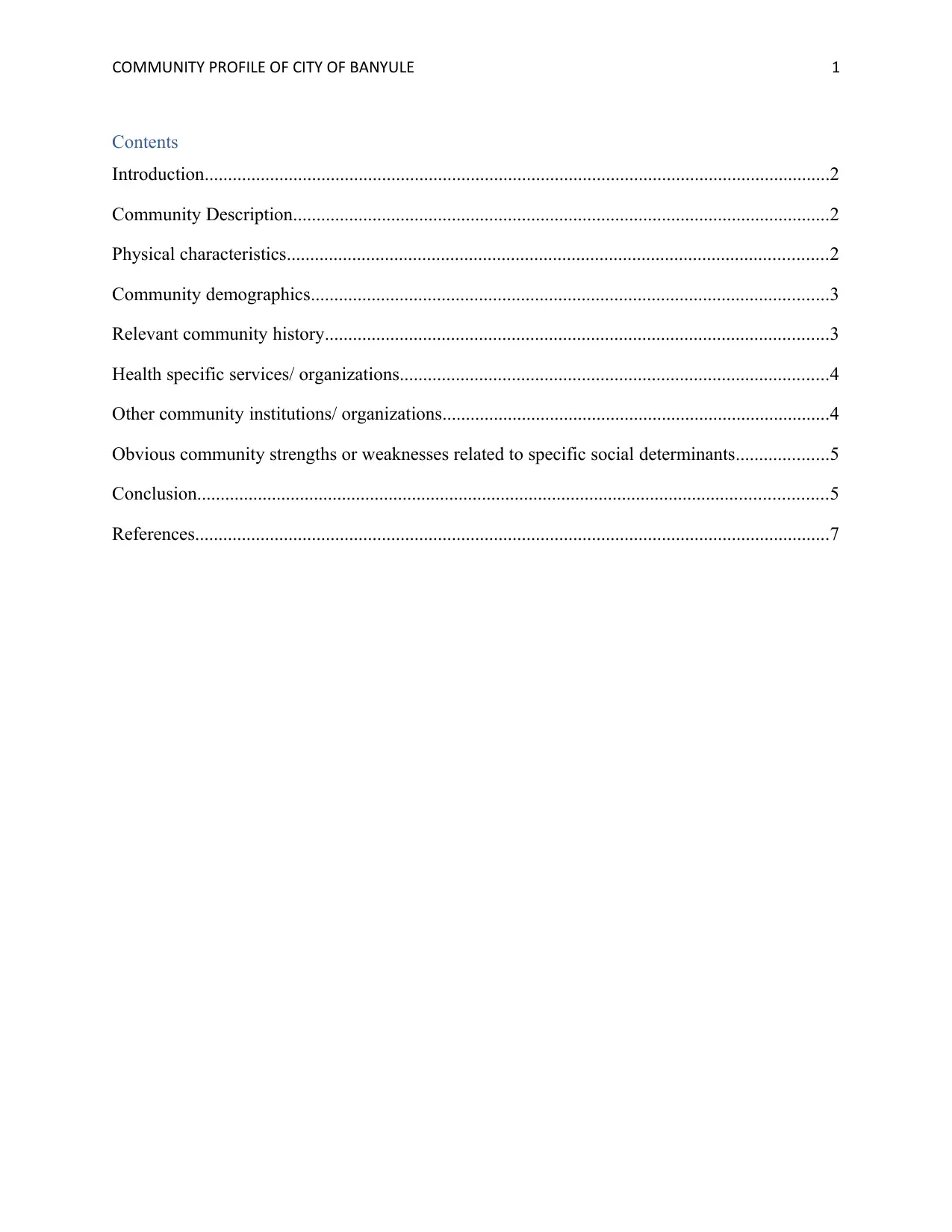
COMMUNITY PROFILE OF CITY OF BANYULE 1
Contents
Introduction......................................................................................................................................2
Community Description...................................................................................................................2
Physical characteristics....................................................................................................................2
Community demographics...............................................................................................................3
Relevant community history............................................................................................................3
Health specific services/ organizations............................................................................................4
Other community institutions/ organizations...................................................................................4
Obvious community strengths or weaknesses related to specific social determinants....................5
Conclusion.......................................................................................................................................5
References........................................................................................................................................7
Contents
Introduction......................................................................................................................................2
Community Description...................................................................................................................2
Physical characteristics....................................................................................................................2
Community demographics...............................................................................................................3
Relevant community history............................................................................................................3
Health specific services/ organizations............................................................................................4
Other community institutions/ organizations...................................................................................4
Obvious community strengths or weaknesses related to specific social determinants....................5
Conclusion.......................................................................................................................................5
References........................................................................................................................................7
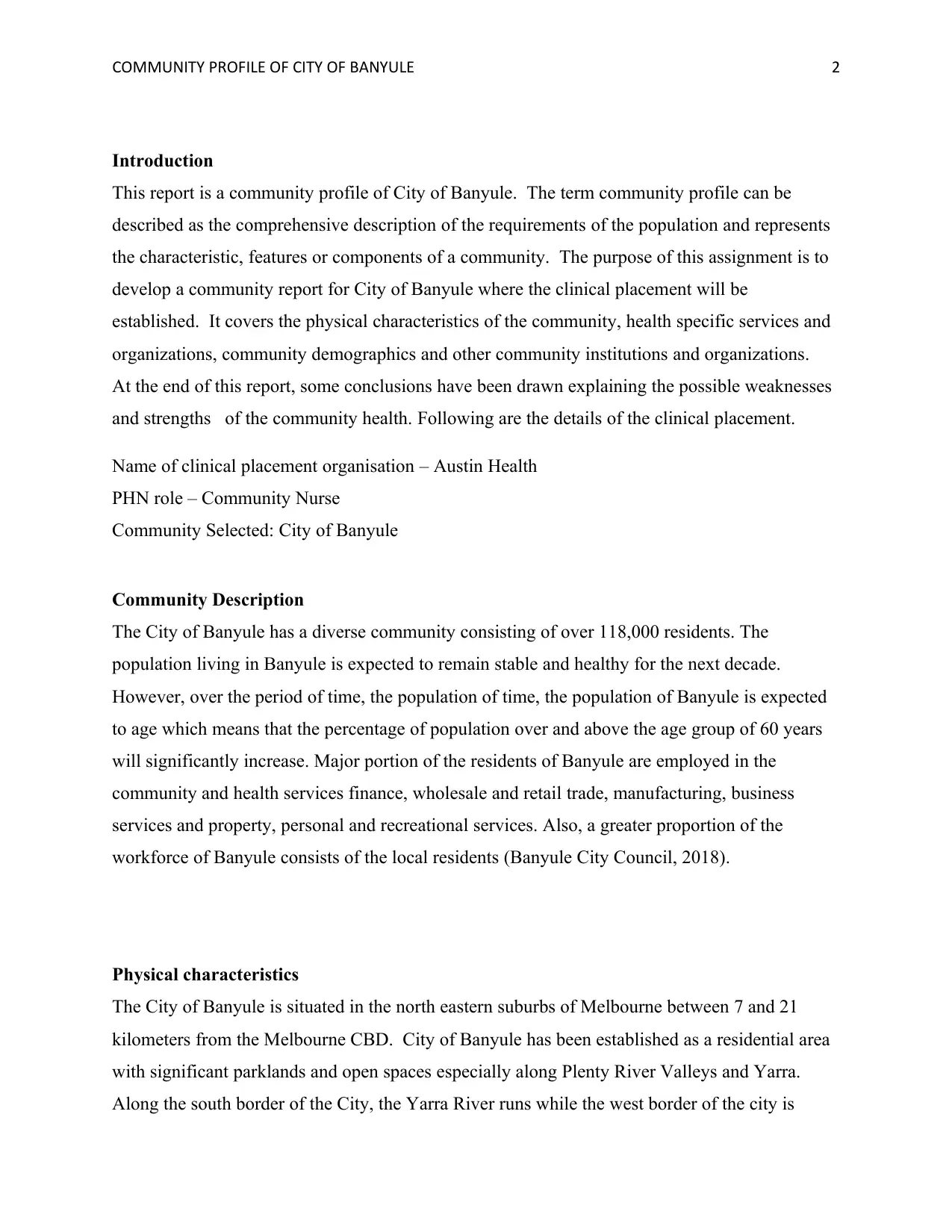
COMMUNITY PROFILE OF CITY OF BANYULE 2
Introduction
This report is a community profile of City of Banyule. The term community profile can be
described as the comprehensive description of the requirements of the population and represents
the characteristic, features or components of a community. The purpose of this assignment is to
develop a community report for City of Banyule where the clinical placement will be
established. It covers the physical characteristics of the community, health specific services and
organizations, community demographics and other community institutions and organizations.
At the end of this report, some conclusions have been drawn explaining the possible weaknesses
and strengths of the community health. Following are the details of the clinical placement.
Name of clinical placement organisation – Austin Health
PHN role – Community Nurse
Community Selected: City of Banyule
Community Description
The City of Banyule has a diverse community consisting of over 118,000 residents. The
population living in Banyule is expected to remain stable and healthy for the next decade.
However, over the period of time, the population of time, the population of Banyule is expected
to age which means that the percentage of population over and above the age group of 60 years
will significantly increase. Major portion of the residents of Banyule are employed in the
community and health services finance, wholesale and retail trade, manufacturing, business
services and property, personal and recreational services. Also, a greater proportion of the
workforce of Banyule consists of the local residents (Banyule City Council, 2018).
Physical characteristics
The City of Banyule is situated in the north eastern suburbs of Melbourne between 7 and 21
kilometers from the Melbourne CBD. City of Banyule has been established as a residential area
with significant parklands and open spaces especially along Plenty River Valleys and Yarra.
Along the south border of the City, the Yarra River runs while the west border of the city is
Introduction
This report is a community profile of City of Banyule. The term community profile can be
described as the comprehensive description of the requirements of the population and represents
the characteristic, features or components of a community. The purpose of this assignment is to
develop a community report for City of Banyule where the clinical placement will be
established. It covers the physical characteristics of the community, health specific services and
organizations, community demographics and other community institutions and organizations.
At the end of this report, some conclusions have been drawn explaining the possible weaknesses
and strengths of the community health. Following are the details of the clinical placement.
Name of clinical placement organisation – Austin Health
PHN role – Community Nurse
Community Selected: City of Banyule
Community Description
The City of Banyule has a diverse community consisting of over 118,000 residents. The
population living in Banyule is expected to remain stable and healthy for the next decade.
However, over the period of time, the population of time, the population of Banyule is expected
to age which means that the percentage of population over and above the age group of 60 years
will significantly increase. Major portion of the residents of Banyule are employed in the
community and health services finance, wholesale and retail trade, manufacturing, business
services and property, personal and recreational services. Also, a greater proportion of the
workforce of Banyule consists of the local residents (Banyule City Council, 2018).
Physical characteristics
The City of Banyule is situated in the north eastern suburbs of Melbourne between 7 and 21
kilometers from the Melbourne CBD. City of Banyule has been established as a residential area
with significant parklands and open spaces especially along Plenty River Valleys and Yarra.
Along the south border of the City, the Yarra River runs while the west border of the city is
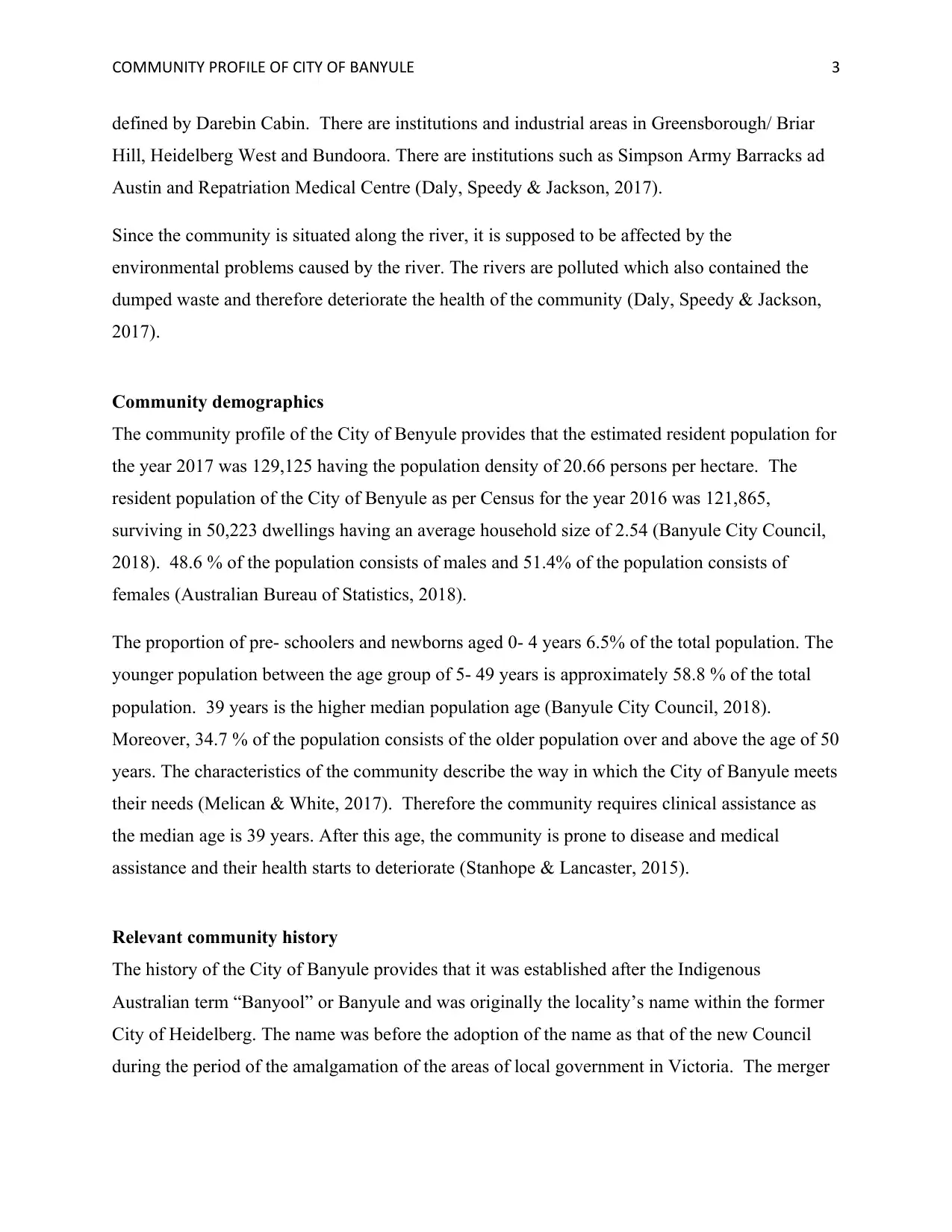
COMMUNITY PROFILE OF CITY OF BANYULE 3
defined by Darebin Cabin. There are institutions and industrial areas in Greensborough/ Briar
Hill, Heidelberg West and Bundoora. There are institutions such as Simpson Army Barracks ad
Austin and Repatriation Medical Centre (Daly, Speedy & Jackson, 2017).
Since the community is situated along the river, it is supposed to be affected by the
environmental problems caused by the river. The rivers are polluted which also contained the
dumped waste and therefore deteriorate the health of the community (Daly, Speedy & Jackson,
2017).
Community demographics
The community profile of the City of Benyule provides that the estimated resident population for
the year 2017 was 129,125 having the population density of 20.66 persons per hectare. The
resident population of the City of Benyule as per Census for the year 2016 was 121,865,
surviving in 50,223 dwellings having an average household size of 2.54 (Banyule City Council,
2018). 48.6 % of the population consists of males and 51.4% of the population consists of
females (Australian Bureau of Statistics, 2018).
The proportion of pre- schoolers and newborns aged 0- 4 years 6.5% of the total population. The
younger population between the age group of 5- 49 years is approximately 58.8 % of the total
population. 39 years is the higher median population age (Banyule City Council, 2018).
Moreover, 34.7 % of the population consists of the older population over and above the age of 50
years. The characteristics of the community describe the way in which the City of Banyule meets
their needs (Melican & White, 2017). Therefore the community requires clinical assistance as
the median age is 39 years. After this age, the community is prone to disease and medical
assistance and their health starts to deteriorate (Stanhope & Lancaster, 2015).
Relevant community history
The history of the City of Banyule provides that it was established after the Indigenous
Australian term “Banyool” or Banyule and was originally the locality’s name within the former
City of Heidelberg. The name was before the adoption of the name as that of the new Council
during the period of the amalgamation of the areas of local government in Victoria. The merger
defined by Darebin Cabin. There are institutions and industrial areas in Greensborough/ Briar
Hill, Heidelberg West and Bundoora. There are institutions such as Simpson Army Barracks ad
Austin and Repatriation Medical Centre (Daly, Speedy & Jackson, 2017).
Since the community is situated along the river, it is supposed to be affected by the
environmental problems caused by the river. The rivers are polluted which also contained the
dumped waste and therefore deteriorate the health of the community (Daly, Speedy & Jackson,
2017).
Community demographics
The community profile of the City of Benyule provides that the estimated resident population for
the year 2017 was 129,125 having the population density of 20.66 persons per hectare. The
resident population of the City of Benyule as per Census for the year 2016 was 121,865,
surviving in 50,223 dwellings having an average household size of 2.54 (Banyule City Council,
2018). 48.6 % of the population consists of males and 51.4% of the population consists of
females (Australian Bureau of Statistics, 2018).
The proportion of pre- schoolers and newborns aged 0- 4 years 6.5% of the total population. The
younger population between the age group of 5- 49 years is approximately 58.8 % of the total
population. 39 years is the higher median population age (Banyule City Council, 2018).
Moreover, 34.7 % of the population consists of the older population over and above the age of 50
years. The characteristics of the community describe the way in which the City of Banyule meets
their needs (Melican & White, 2017). Therefore the community requires clinical assistance as
the median age is 39 years. After this age, the community is prone to disease and medical
assistance and their health starts to deteriorate (Stanhope & Lancaster, 2015).
Relevant community history
The history of the City of Banyule provides that it was established after the Indigenous
Australian term “Banyool” or Banyule and was originally the locality’s name within the former
City of Heidelberg. The name was before the adoption of the name as that of the new Council
during the period of the amalgamation of the areas of local government in Victoria. The merger
Secure Best Marks with AI Grader
Need help grading? Try our AI Grader for instant feedback on your assignments.
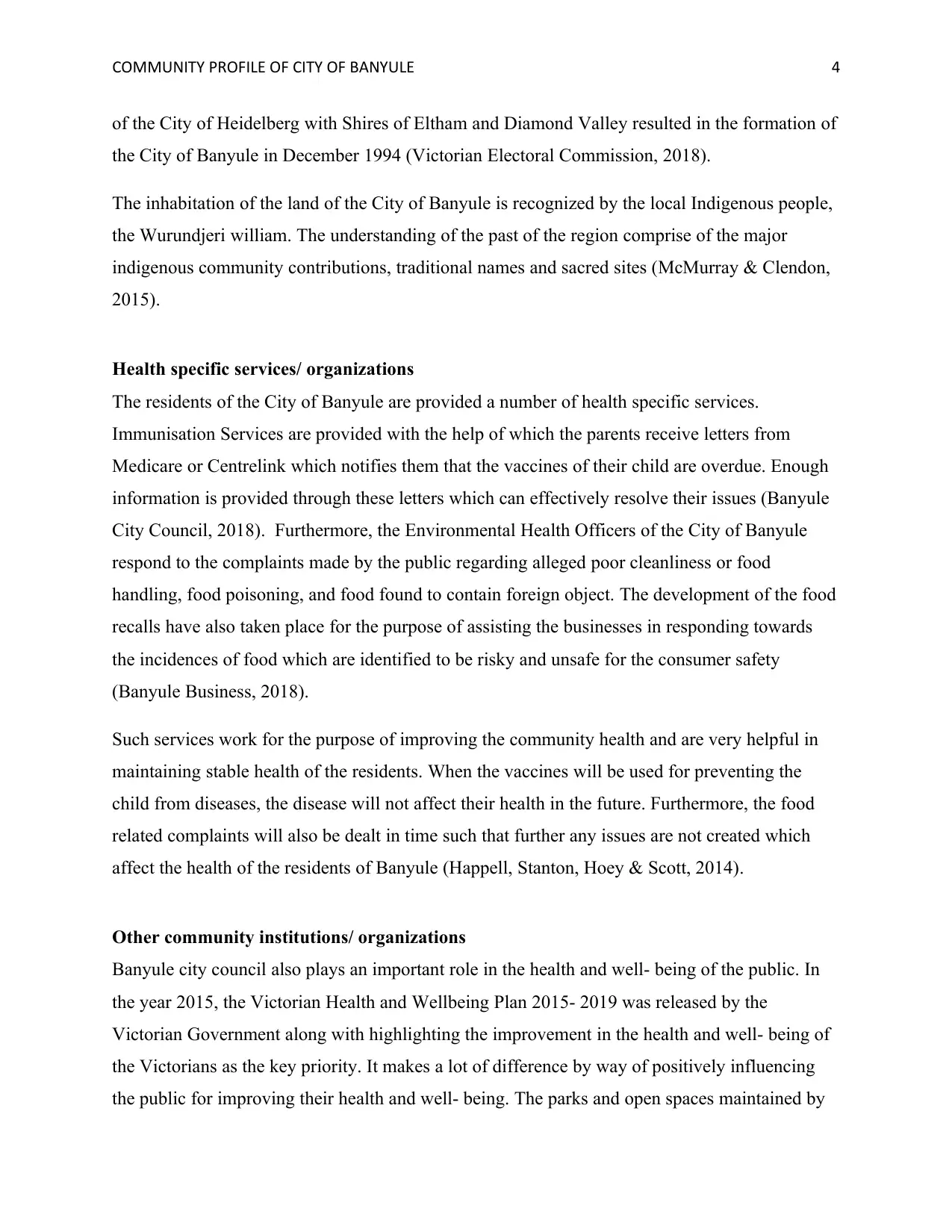
COMMUNITY PROFILE OF CITY OF BANYULE 4
of the City of Heidelberg with Shires of Eltham and Diamond Valley resulted in the formation of
the City of Banyule in December 1994 (Victorian Electoral Commission, 2018).
The inhabitation of the land of the City of Banyule is recognized by the local Indigenous people,
the Wurundjeri william. The understanding of the past of the region comprise of the major
indigenous community contributions, traditional names and sacred sites (McMurray & Clendon,
2015).
Health specific services/ organizations
The residents of the City of Banyule are provided a number of health specific services.
Immunisation Services are provided with the help of which the parents receive letters from
Medicare or Centrelink which notifies them that the vaccines of their child are overdue. Enough
information is provided through these letters which can effectively resolve their issues (Banyule
City Council, 2018). Furthermore, the Environmental Health Officers of the City of Banyule
respond to the complaints made by the public regarding alleged poor cleanliness or food
handling, food poisoning, and food found to contain foreign object. The development of the food
recalls have also taken place for the purpose of assisting the businesses in responding towards
the incidences of food which are identified to be risky and unsafe for the consumer safety
(Banyule Business, 2018).
Such services work for the purpose of improving the community health and are very helpful in
maintaining stable health of the residents. When the vaccines will be used for preventing the
child from diseases, the disease will not affect their health in the future. Furthermore, the food
related complaints will also be dealt in time such that further any issues are not created which
affect the health of the residents of Banyule (Happell, Stanton, Hoey & Scott, 2014).
Other community institutions/ organizations
Banyule city council also plays an important role in the health and well- being of the public. In
the year 2015, the Victorian Health and Wellbeing Plan 2015- 2019 was released by the
Victorian Government along with highlighting the improvement in the health and well- being of
the Victorians as the key priority. It makes a lot of difference by way of positively influencing
the public for improving their health and well- being. The parks and open spaces maintained by
of the City of Heidelberg with Shires of Eltham and Diamond Valley resulted in the formation of
the City of Banyule in December 1994 (Victorian Electoral Commission, 2018).
The inhabitation of the land of the City of Banyule is recognized by the local Indigenous people,
the Wurundjeri william. The understanding of the past of the region comprise of the major
indigenous community contributions, traditional names and sacred sites (McMurray & Clendon,
2015).
Health specific services/ organizations
The residents of the City of Banyule are provided a number of health specific services.
Immunisation Services are provided with the help of which the parents receive letters from
Medicare or Centrelink which notifies them that the vaccines of their child are overdue. Enough
information is provided through these letters which can effectively resolve their issues (Banyule
City Council, 2018). Furthermore, the Environmental Health Officers of the City of Banyule
respond to the complaints made by the public regarding alleged poor cleanliness or food
handling, food poisoning, and food found to contain foreign object. The development of the food
recalls have also taken place for the purpose of assisting the businesses in responding towards
the incidences of food which are identified to be risky and unsafe for the consumer safety
(Banyule Business, 2018).
Such services work for the purpose of improving the community health and are very helpful in
maintaining stable health of the residents. When the vaccines will be used for preventing the
child from diseases, the disease will not affect their health in the future. Furthermore, the food
related complaints will also be dealt in time such that further any issues are not created which
affect the health of the residents of Banyule (Happell, Stanton, Hoey & Scott, 2014).
Other community institutions/ organizations
Banyule city council also plays an important role in the health and well- being of the public. In
the year 2015, the Victorian Health and Wellbeing Plan 2015- 2019 was released by the
Victorian Government along with highlighting the improvement in the health and well- being of
the Victorians as the key priority. It makes a lot of difference by way of positively influencing
the public for improving their health and well- being. The parks and open spaces maintained by
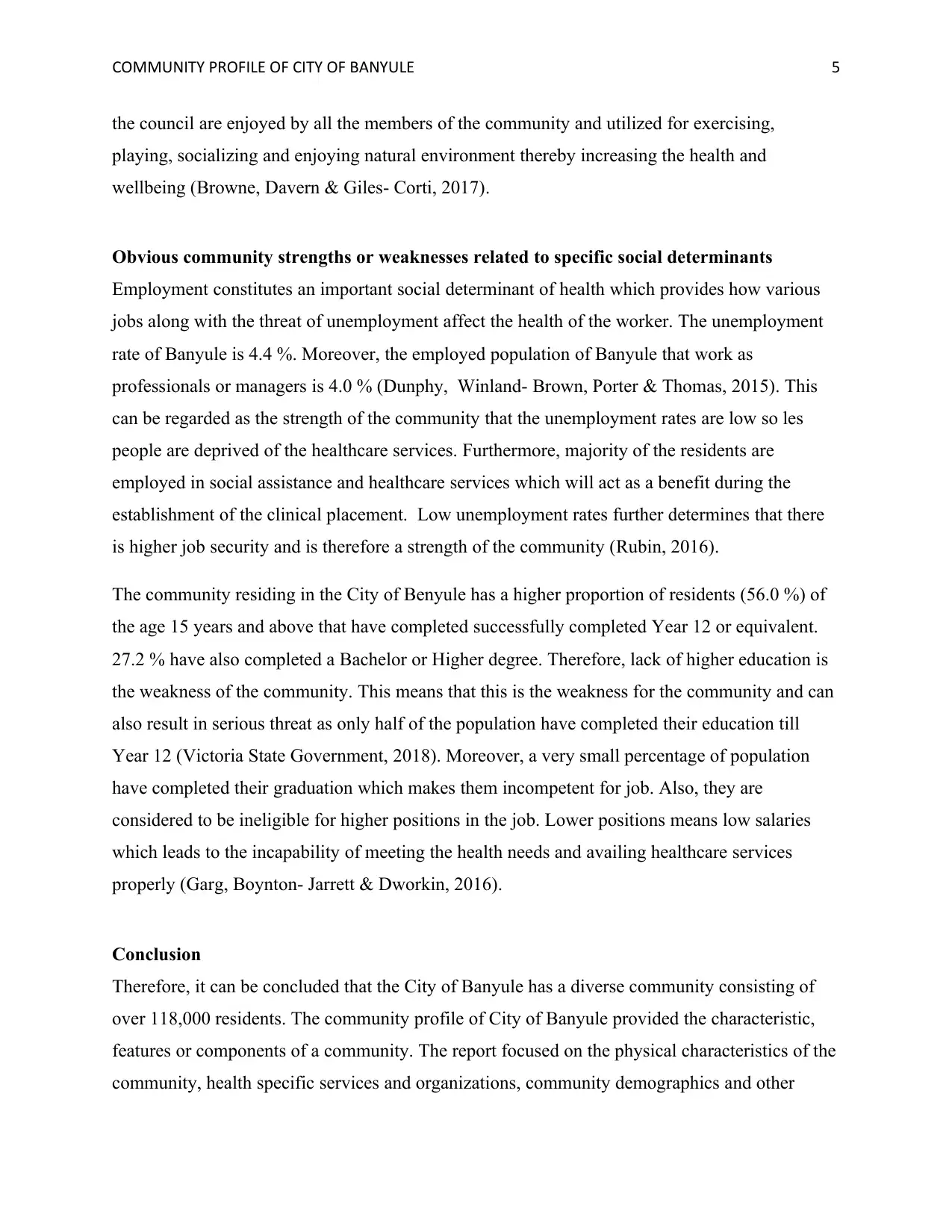
COMMUNITY PROFILE OF CITY OF BANYULE 5
the council are enjoyed by all the members of the community and utilized for exercising,
playing, socializing and enjoying natural environment thereby increasing the health and
wellbeing (Browne, Davern & Giles- Corti, 2017).
Obvious community strengths or weaknesses related to specific social determinants
Employment constitutes an important social determinant of health which provides how various
jobs along with the threat of unemployment affect the health of the worker. The unemployment
rate of Banyule is 4.4 %. Moreover, the employed population of Banyule that work as
professionals or managers is 4.0 % (Dunphy, Winland- Brown, Porter & Thomas, 2015). This
can be regarded as the strength of the community that the unemployment rates are low so les
people are deprived of the healthcare services. Furthermore, majority of the residents are
employed in social assistance and healthcare services which will act as a benefit during the
establishment of the clinical placement. Low unemployment rates further determines that there
is higher job security and is therefore a strength of the community (Rubin, 2016).
The community residing in the City of Benyule has a higher proportion of residents (56.0 %) of
the age 15 years and above that have completed successfully completed Year 12 or equivalent.
27.2 % have also completed a Bachelor or Higher degree. Therefore, lack of higher education is
the weakness of the community. This means that this is the weakness for the community and can
also result in serious threat as only half of the population have completed their education till
Year 12 (Victoria State Government, 2018). Moreover, a very small percentage of population
have completed their graduation which makes them incompetent for job. Also, they are
considered to be ineligible for higher positions in the job. Lower positions means low salaries
which leads to the incapability of meeting the health needs and availing healthcare services
properly (Garg, Boynton- Jarrett & Dworkin, 2016).
Conclusion
Therefore, it can be concluded that the City of Banyule has a diverse community consisting of
over 118,000 residents. The community profile of City of Banyule provided the characteristic,
features or components of a community. The report focused on the physical characteristics of the
community, health specific services and organizations, community demographics and other
the council are enjoyed by all the members of the community and utilized for exercising,
playing, socializing and enjoying natural environment thereby increasing the health and
wellbeing (Browne, Davern & Giles- Corti, 2017).
Obvious community strengths or weaknesses related to specific social determinants
Employment constitutes an important social determinant of health which provides how various
jobs along with the threat of unemployment affect the health of the worker. The unemployment
rate of Banyule is 4.4 %. Moreover, the employed population of Banyule that work as
professionals or managers is 4.0 % (Dunphy, Winland- Brown, Porter & Thomas, 2015). This
can be regarded as the strength of the community that the unemployment rates are low so les
people are deprived of the healthcare services. Furthermore, majority of the residents are
employed in social assistance and healthcare services which will act as a benefit during the
establishment of the clinical placement. Low unemployment rates further determines that there
is higher job security and is therefore a strength of the community (Rubin, 2016).
The community residing in the City of Benyule has a higher proportion of residents (56.0 %) of
the age 15 years and above that have completed successfully completed Year 12 or equivalent.
27.2 % have also completed a Bachelor or Higher degree. Therefore, lack of higher education is
the weakness of the community. This means that this is the weakness for the community and can
also result in serious threat as only half of the population have completed their education till
Year 12 (Victoria State Government, 2018). Moreover, a very small percentage of population
have completed their graduation which makes them incompetent for job. Also, they are
considered to be ineligible for higher positions in the job. Lower positions means low salaries
which leads to the incapability of meeting the health needs and availing healthcare services
properly (Garg, Boynton- Jarrett & Dworkin, 2016).
Conclusion
Therefore, it can be concluded that the City of Banyule has a diverse community consisting of
over 118,000 residents. The community profile of City of Banyule provided the characteristic,
features or components of a community. The report focused on the physical characteristics of the
community, health specific services and organizations, community demographics and other
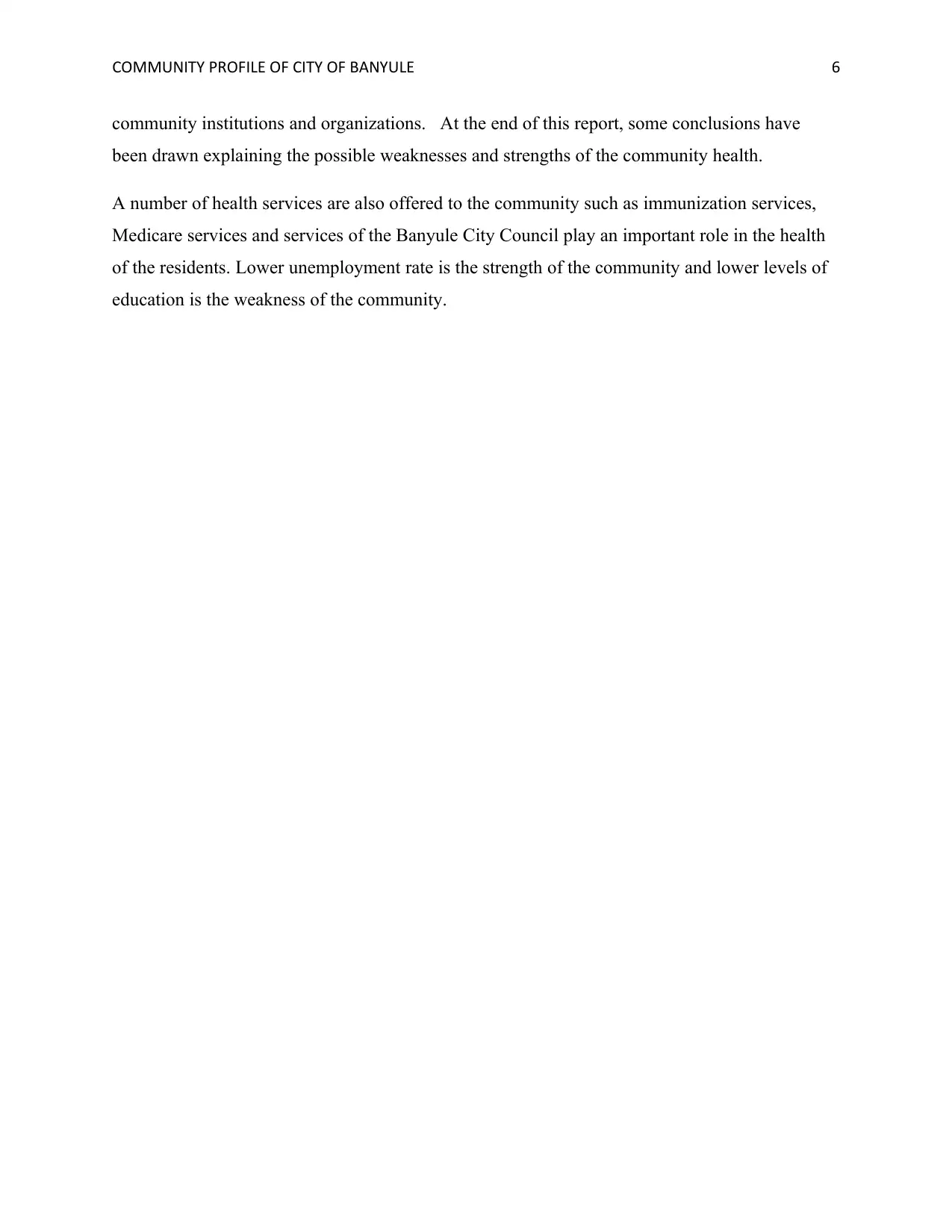
COMMUNITY PROFILE OF CITY OF BANYULE 6
community institutions and organizations. At the end of this report, some conclusions have
been drawn explaining the possible weaknesses and strengths of the community health.
A number of health services are also offered to the community such as immunization services,
Medicare services and services of the Banyule City Council play an important role in the health
of the residents. Lower unemployment rate is the strength of the community and lower levels of
education is the weakness of the community.
community institutions and organizations. At the end of this report, some conclusions have
been drawn explaining the possible weaknesses and strengths of the community health.
A number of health services are also offered to the community such as immunization services,
Medicare services and services of the Banyule City Council play an important role in the health
of the residents. Lower unemployment rate is the strength of the community and lower levels of
education is the weakness of the community.
Paraphrase This Document
Need a fresh take? Get an instant paraphrase of this document with our AI Paraphraser
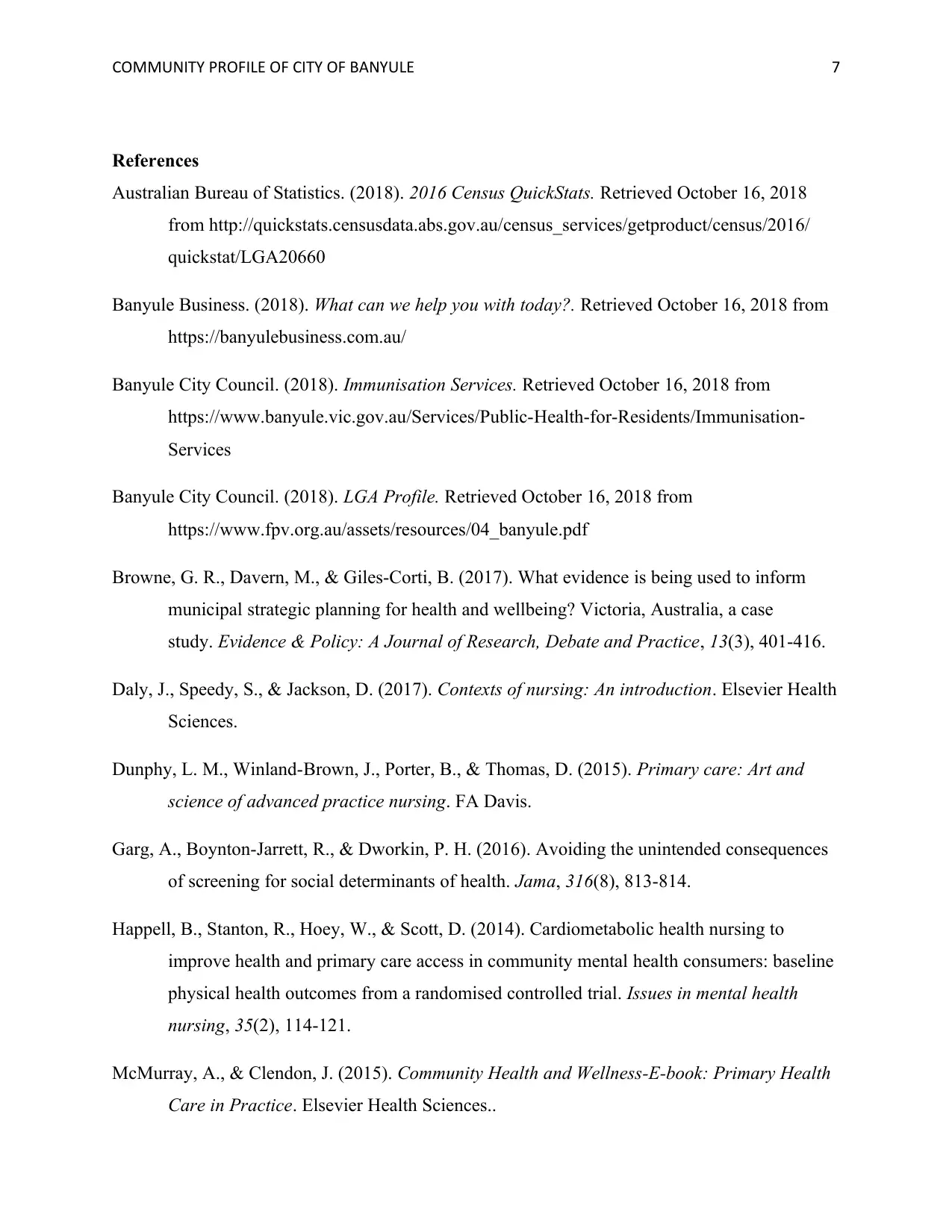
COMMUNITY PROFILE OF CITY OF BANYULE 7
References
Australian Bureau of Statistics. (2018). 2016 Census QuickStats. Retrieved October 16, 2018
from http://quickstats.censusdata.abs.gov.au/census_services/getproduct/census/2016/
quickstat/LGA20660
Banyule Business. (2018). What can we help you with today?. Retrieved October 16, 2018 from
https://banyulebusiness.com.au/
Banyule City Council. (2018). Immunisation Services. Retrieved October 16, 2018 from
https://www.banyule.vic.gov.au/Services/Public-Health-for-Residents/Immunisation-
Services
Banyule City Council. (2018). LGA Profile. Retrieved October 16, 2018 from
https://www.fpv.org.au/assets/resources/04_banyule.pdf
Browne, G. R., Davern, M., & Giles-Corti, B. (2017). What evidence is being used to inform
municipal strategic planning for health and wellbeing? Victoria, Australia, a case
study. Evidence & Policy: A Journal of Research, Debate and Practice, 13(3), 401-416.
Daly, J., Speedy, S., & Jackson, D. (2017). Contexts of nursing: An introduction. Elsevier Health
Sciences.
Dunphy, L. M., Winland-Brown, J., Porter, B., & Thomas, D. (2015). Primary care: Art and
science of advanced practice nursing. FA Davis.
Garg, A., Boynton-Jarrett, R., & Dworkin, P. H. (2016). Avoiding the unintended consequences
of screening for social determinants of health. Jama, 316(8), 813-814.
Happell, B., Stanton, R., Hoey, W., & Scott, D. (2014). Cardiometabolic health nursing to
improve health and primary care access in community mental health consumers: baseline
physical health outcomes from a randomised controlled trial. Issues in mental health
nursing, 35(2), 114-121.
McMurray, A., & Clendon, J. (2015). Community Health and Wellness-E-book: Primary Health
Care in Practice. Elsevier Health Sciences..
References
Australian Bureau of Statistics. (2018). 2016 Census QuickStats. Retrieved October 16, 2018
from http://quickstats.censusdata.abs.gov.au/census_services/getproduct/census/2016/
quickstat/LGA20660
Banyule Business. (2018). What can we help you with today?. Retrieved October 16, 2018 from
https://banyulebusiness.com.au/
Banyule City Council. (2018). Immunisation Services. Retrieved October 16, 2018 from
https://www.banyule.vic.gov.au/Services/Public-Health-for-Residents/Immunisation-
Services
Banyule City Council. (2018). LGA Profile. Retrieved October 16, 2018 from
https://www.fpv.org.au/assets/resources/04_banyule.pdf
Browne, G. R., Davern, M., & Giles-Corti, B. (2017). What evidence is being used to inform
municipal strategic planning for health and wellbeing? Victoria, Australia, a case
study. Evidence & Policy: A Journal of Research, Debate and Practice, 13(3), 401-416.
Daly, J., Speedy, S., & Jackson, D. (2017). Contexts of nursing: An introduction. Elsevier Health
Sciences.
Dunphy, L. M., Winland-Brown, J., Porter, B., & Thomas, D. (2015). Primary care: Art and
science of advanced practice nursing. FA Davis.
Garg, A., Boynton-Jarrett, R., & Dworkin, P. H. (2016). Avoiding the unintended consequences
of screening for social determinants of health. Jama, 316(8), 813-814.
Happell, B., Stanton, R., Hoey, W., & Scott, D. (2014). Cardiometabolic health nursing to
improve health and primary care access in community mental health consumers: baseline
physical health outcomes from a randomised controlled trial. Issues in mental health
nursing, 35(2), 114-121.
McMurray, A., & Clendon, J. (2015). Community Health and Wellness-E-book: Primary Health
Care in Practice. Elsevier Health Sciences..
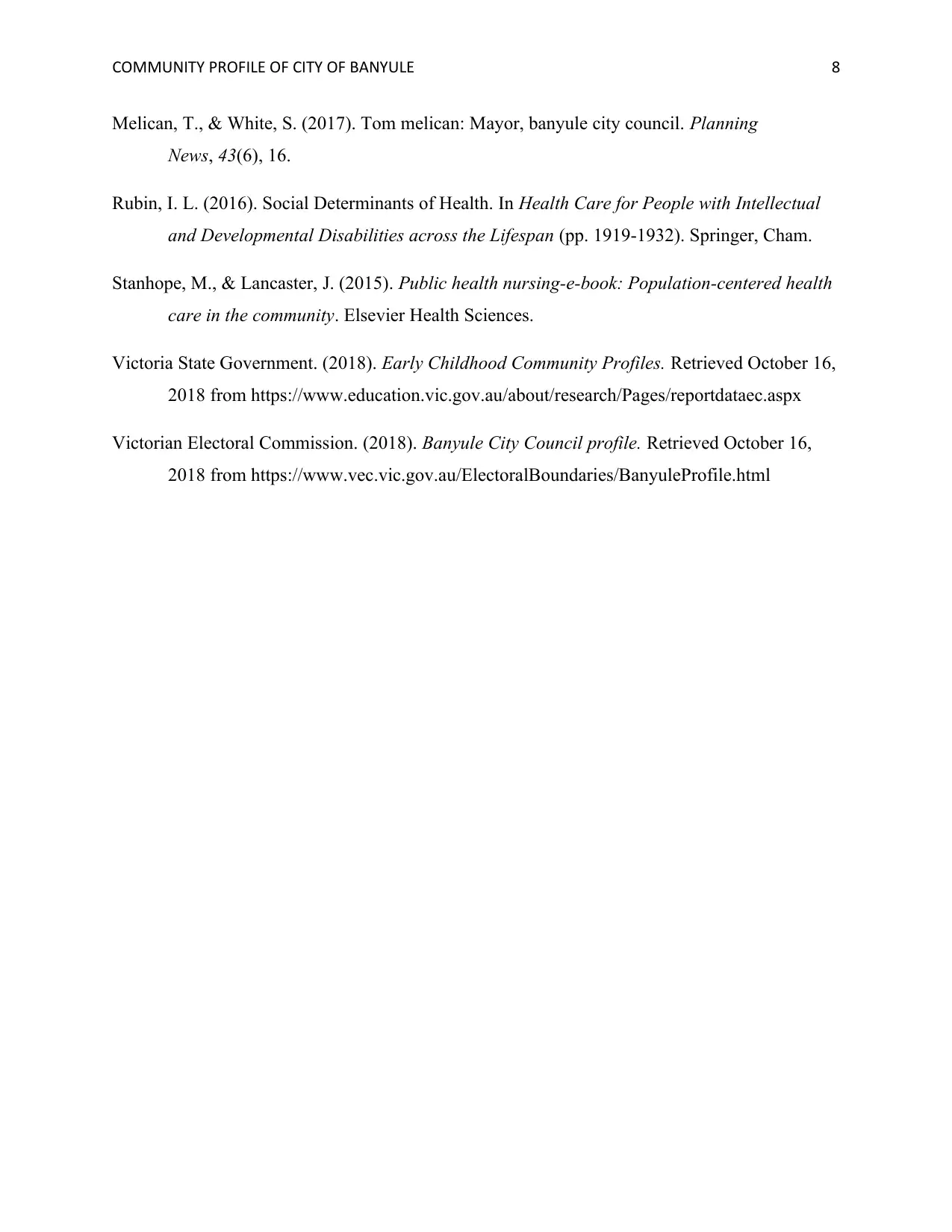
COMMUNITY PROFILE OF CITY OF BANYULE 8
Melican, T., & White, S. (2017). Tom melican: Mayor, banyule city council. Planning
News, 43(6), 16.
Rubin, I. L. (2016). Social Determinants of Health. In Health Care for People with Intellectual
and Developmental Disabilities across the Lifespan (pp. 1919-1932). Springer, Cham.
Stanhope, M., & Lancaster, J. (2015). Public health nursing-e-book: Population-centered health
care in the community. Elsevier Health Sciences.
Victoria State Government. (2018). Early Childhood Community Profiles. Retrieved October 16,
2018 from https://www.education.vic.gov.au/about/research/Pages/reportdataec.aspx
Victorian Electoral Commission. (2018). Banyule City Council profile. Retrieved October 16,
2018 from https://www.vec.vic.gov.au/ElectoralBoundaries/BanyuleProfile.html
Melican, T., & White, S. (2017). Tom melican: Mayor, banyule city council. Planning
News, 43(6), 16.
Rubin, I. L. (2016). Social Determinants of Health. In Health Care for People with Intellectual
and Developmental Disabilities across the Lifespan (pp. 1919-1932). Springer, Cham.
Stanhope, M., & Lancaster, J. (2015). Public health nursing-e-book: Population-centered health
care in the community. Elsevier Health Sciences.
Victoria State Government. (2018). Early Childhood Community Profiles. Retrieved October 16,
2018 from https://www.education.vic.gov.au/about/research/Pages/reportdataec.aspx
Victorian Electoral Commission. (2018). Banyule City Council profile. Retrieved October 16,
2018 from https://www.vec.vic.gov.au/ElectoralBoundaries/BanyuleProfile.html
1 out of 9
Your All-in-One AI-Powered Toolkit for Academic Success.
+13062052269
info@desklib.com
Available 24*7 on WhatsApp / Email
![[object Object]](/_next/static/media/star-bottom.7253800d.svg)
Unlock your academic potential
© 2024 | Zucol Services PVT LTD | All rights reserved.